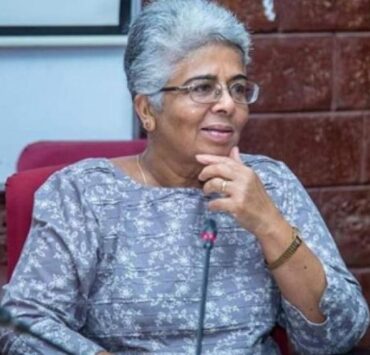
By Editors

NWMI Member Ninan has been in journalism since 1974. She worked for The Hindustan Times and The Indian Express before writing a media column for The Hindu for the last 11 years. She now edits www.thehoot.org, a media watch website for South Asia. She has written three books that include Through The Magic Window, which is about television and change in India. She can be contacted at sevantininan@vsnl.com
This interview is by arrangement with www.prdomain.com
What are the challenges faced by the Indian media today?
Of enforcing more rigorous professional standards, of responding to the need for more serious reporting on governance issues, of upholding its own freedom to function in the face of browbeating by the government of the day.
How would you rate Indian journalism on a scale of one to ten in terms of credibility, quality and personnel?
There cannot be any consolidated rating of Indian journalism because its quality varies so much across publications, across regions. It is capable of both outstanding professionalism as well as cold-blooded communal mischief making. At the top of the rung, personnel are brighter and better educated than any time earlier. At the bottom, non-journalists are increasingly employed as stringers, which was not the case earlier. I think the big problem in Indian journalism today is the lack of experience and quality at the copy desk.
Despite journalism in Indian languages coming of age, the English-language media in the country continues to dominate its vernacular cousins. What’s your view on this?
Dominate in what way? Hindi television gets more advertising than programmes in English. Regional publications dominate the readership figures. In the latest Indian Readership Survey of the top ten publications in terms of readership, only the last one is an English publication. In magazines, too, Hindi publications dominate. There may be more traditional prestige associated with the English media, but with the coming of the Hindi news channels from major media houses and with the growth of a newspaper like Dainik Bhaskar, that is changing.
Some observers of the Indian media contend that liberalisation and consumerism have led to the trivialisation of journalism in the country, to the triumph of puff over ‘real’ issues. Does this charge hold water and, if so, what does this development portend?
Liberalisation has led to the media targeting readers as consumers rather than citizens. There is a burgeoning of frothy supplements, loads of newsprint devoted to non-issues. It leads to the invisibility of those on the margin, which means those who make policy don’t read about them and their problems as much as they should. Food and fashion journalism is unfortunately no longer confined to metropolitan cities, the regional papers are going the same way increasingly, because they too are targeting the upwardly mobile consumers in their cities. It’s a serious issue because agriculture, education, employment and health need more coverage than they presently get. We have lots of newsprint devoted to food as a lifestyle thing. None devoted to hunger which stalks substantial sections of the population.
What do you make of ‘celebrity journalism’ of the kind indulged in by Arundhati Roy and others?
Arundhati Roy is intelligent, articulate and committed to issues so its unfair to dismiss her writings as celebrity journalism. I don’t necessarily buy her point of view or her selective use of facts. The problem is that her celebrity status influences readers who are dazzled by her wit and do not care to think for themselves.
Is the space for print journalism being eroded by the expansion of the television medium and the growing power of the Internet?
The space for print journalism is there but publications abuse it by peddling froth and PR journalism.
What’s your stand on foreign direct investment (FDI) in mainstream Indian print publications, and what’s the reason for the sharp divide on this issue?
There is no divide based on conviction. The biggest opponents of FDI in print are papers who will happily get a foreign partner tomorrow when the rules are spelt out. Both The Times of India and The Hindustan Times were themselves talking to foreign publications about investment before they began their campaign to keep the foreign media out. I think FDI should be allowed on a case-by-case basis.
How bad is the problem of media publications pandering to their business and political interests. Can this be countered and, if so, how?
The problem is growing and would not be there if the country had proper watchdog bodies for the media. We need more ombudsmen in newspapers. We need readers’ editors, who take up cudgels on behalf of readers when newspapers are misused by proprietors. We need a press council with teeth.
The independent journalist who can report any news the way he or she sees it – is this creature more of a myth than ever before?
If we had better training within newspapers, and more refresher courses for working journalists, the quality of journalism would be maintained. There are lots of well-meaning, sincere journalists around. If they don’t do a good job it is not because of a lack of independence. Everybody is not bought out. It is because their notions of journalism are not being constantly honed by seniors who know better.
Is there merit in the contention that Indian journalists cannot – should not – operate by the rules of the Western media (the truth above all else) when it comes to issues such as communal clashes?
It is possible to report the truth sensitively and responsibly.
Business journalism has grown by leaps and bounds since the beginning of the 1990s, and so has its influence. What do you attribute this to?
The changes in the economy. The influx of multinational advertising to support such publications. The growth of PR agencies. The growth of the business sector of the economy in general. The growth of TV and its promotion of business programmes.
You have been in journalism for long. Do you still get a buzz from it?
Yes.
Which Indian print publications do you rate as world class and why?
The Indian Express, The Times of India, The Hindu, Outlook, India Today, Business Standard, BusinessWorld, Down to Earth. For different reasons: some are lively and independent, others have some intellectual pedigree, all of the above are pretty well produced. In any case what is world class? Some of the stuff Time Asia dishes out isn’t all that classy.
Where do you see the Indian media 25 years down the road?
Substantially localised, as well as globalised. The leading TV channels and publications will grow outward into international editions, and regional newspapers will complete their penetration into villages when literacy is almost universal.




